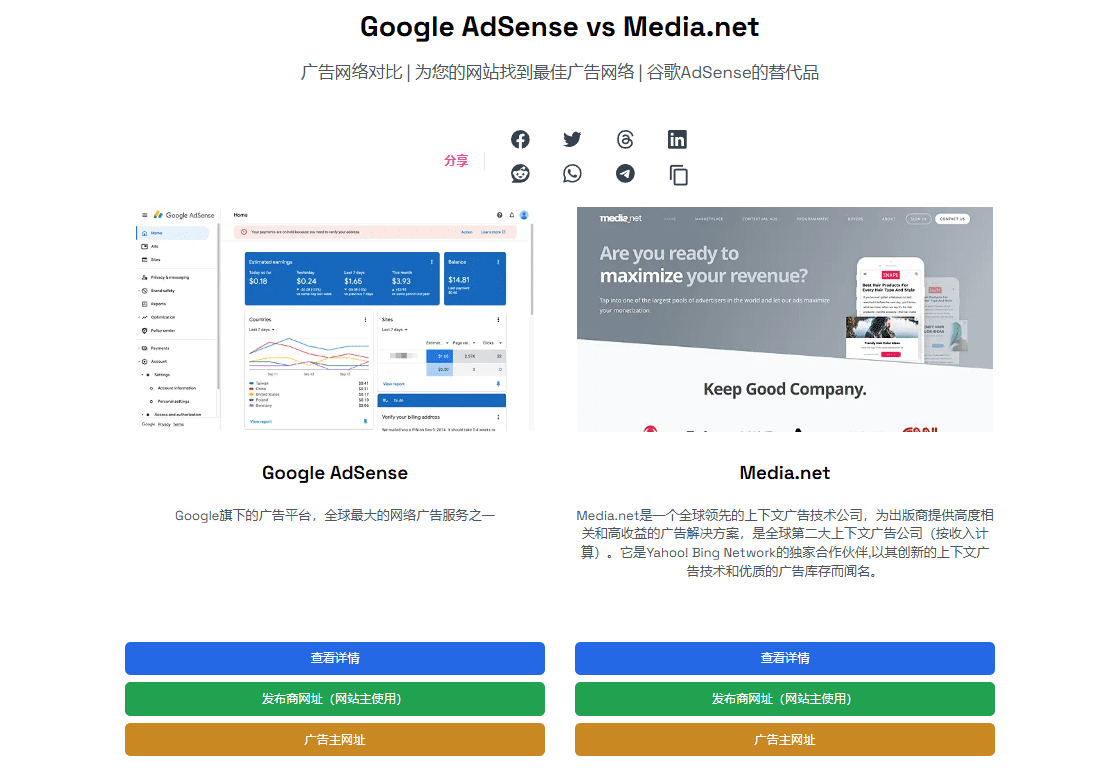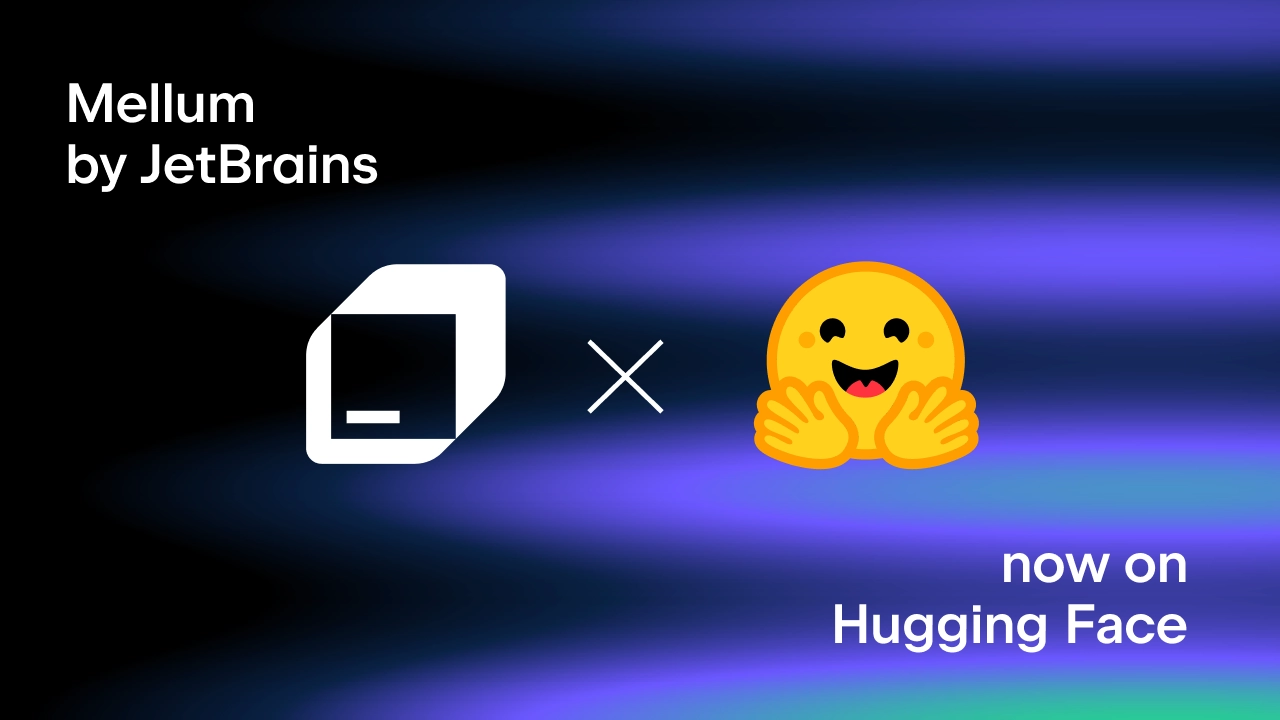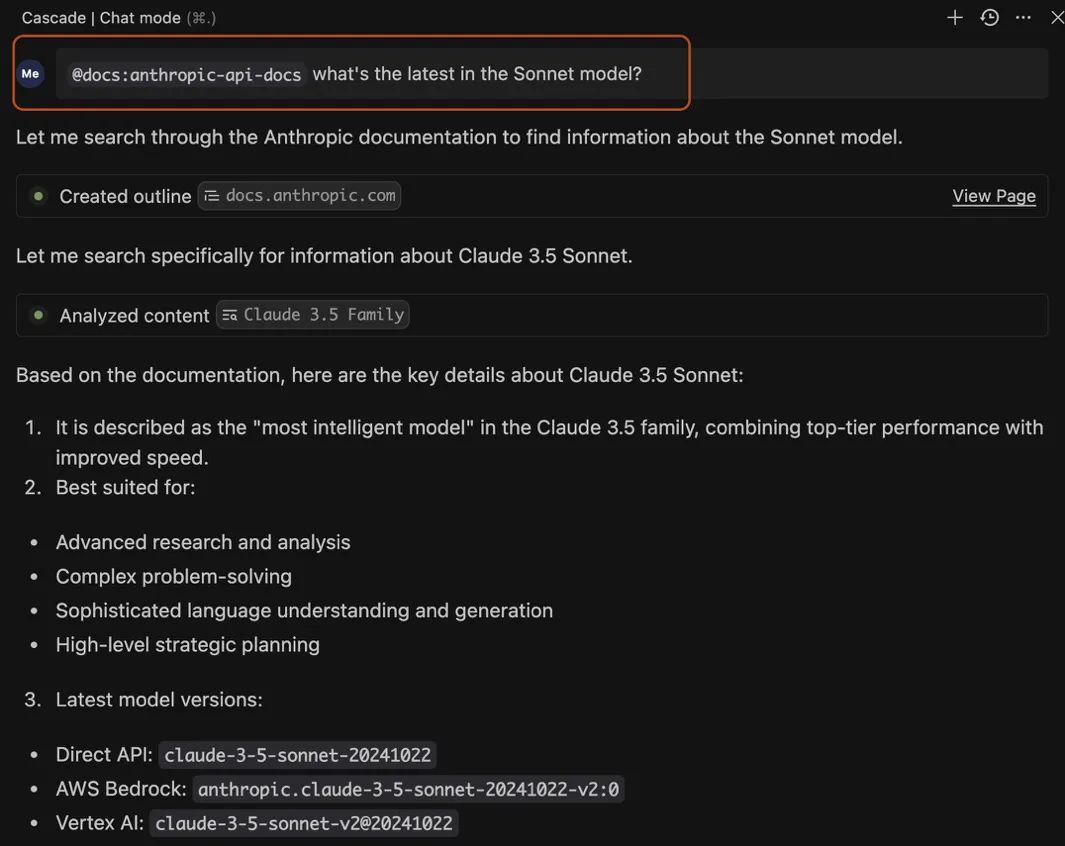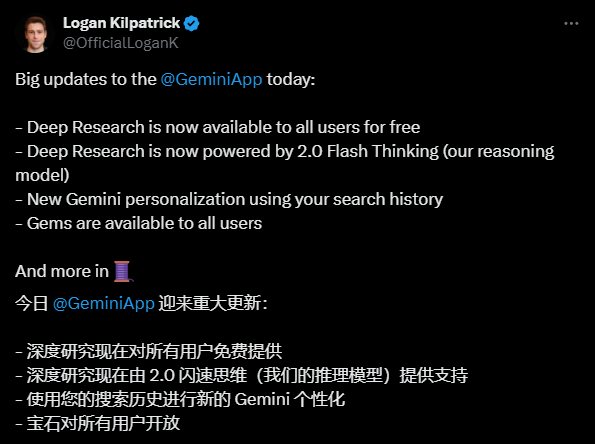No need to program, everyone can develop apps! Baidu's "Seconda" Leads the Code-Free Era
At the 2024 Baidu World Congress, Baidu founder Robin Li formally released the code-free development tool "sida", an innovative product that will revolutionize ordinary people's perception of software development. With "Seconda", users can quickly build applications by simply describing their needs in natural language, truly realizing the vision of "making money on ideas".
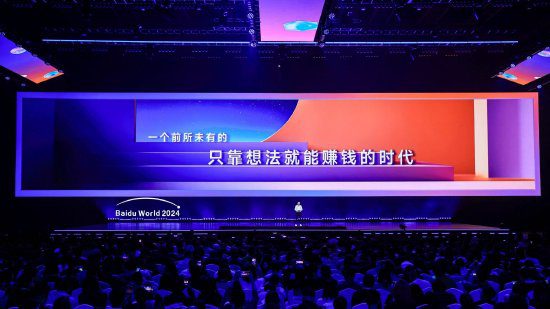
What's a "sec-da-da"?
"Seconda" is a zero-code AI development platform launched by Baidu, which aims to make it easy for users without a programming background to develop apps. Its core features include:
Baidu's no-code development platform "Seconda" has attracted a lot of attention in the market, and it has significant advantages over other no-code tools. The following is an analysis of the main advantages of "Seconda":
1. Programming capability without code
"Seconda allows users to generate applications by describing requirements in natural language without writing any code. This feature makes it easy for non-technical people to get started and quickly realize their ideas. In contrast, many other no-code tools still require users to have a technical background or understand basic programming logic.
2. Multi-intelligence collaboration
"Seconda has multiple built-in intelligences that can work together to handle complex tasks. This multi-intelligence collaboration allows users to direct different intelligences to accomplish tasks as if they were a team. This is rare in other no-code tools, most of which only provide single-function automation and lack the flexibility to collaborate.
3. Rich tool calls
"Seconda supports a wide range of APIs and tool calls, including web search, map APIs, etc., which enables users to easily integrate external services and data when building applications. Many traditional no-code platforms have limited support in this area, and users may need additional technical support for complex integrations.
4. Intuitive and easy-to-use interface
"Seconda provides an intuitive graphical interface that allows users to build applications through simple drag-and-drop and configuration. This user-friendly design greatly reduces the learning curve and allows more people to get started quickly [1][4]. In contrast, some other no-code tools may have a more complex interface design, making it difficult for beginners to adapt.
5. Modular approach to construction
"Seconda" has a modular design that allows users to build the software like building blocks. This flexibility allows users to quickly adapt and extend application functionality as needed without having to redevelop it from scratch [1][2]. Some other no-code platforms often lack this flexibility, limiting user creativity.
6. Strong AI support
Based on Baidu's powerful AI technology, "Seconda" is able to provide smarter suggestions and automated processing capabilities. This makes application development not only a simple function implementation, but also an intelligent process [2][4]. Other no-code tools may be relatively weak in AI integration and unable to fully utilize the latest AI technology to improve development efficiency.
To summarize, "Seconda" significantly improves the ability of ordinary users to develop applications through its unique no-code programming, multi-intelligence body collaboration, rich tool invocation, intuitive interface, modular construction and strong AI support, opening a new no-code era.
Robin Li demonstrated at the conference how to use the "second da" quickly build an event registration system, just describe the needs and upload the relevant documents, multiple intelligent body will automatically collaborate to complete the task. This process not only demonstrates the powerful functions of "si-da", but also reflects its convenience in practical applications.
Wide range of application scenarios
Baidu's no-code development tool "Seconda" has great potential to be used in small businesses to help them efficiently realize digital transformation. Here are some specific use cases and scenarios:
1. Customer relationship management (CRM) systems
Small businesses can quickly build their own customer relationship management system with Seconda. By describing requirements in natural language, business owners can create a system that integrates customer information, sales tracking, and customer interactions without having to hire professional programmers. This flexibility allows businesses to quickly adjust and optimize their customer management strategy in response to market changes.
2. Order processing system
"Seconda helps small businesses develop order processing systems that streamline the process of receiving, processing and tracking orders. Users simply describe the functionality they need and the system automatically generates the appropriate application. This automated process not only increases efficiency, but also reduces human error.
3. Inventory management
Smaller retailers can use Seconda to build an inventory management system that tracks inventory in real time. Through intelligent collaboration, the system is able to automatically alert inventory shortages and generate replenishment orders. This feature is critical to improving supply chain efficiency.
4. Financial report generation
Small businesses often face the problem of cumbersome preparation of financial reports. "Seconda allows users to enter financial data and reporting requirements in natural language to automatically generate financial statements. This greatly reduces the workload of finance staff and allows them to devote more energy to business development.
5. Management of marketing activities
Small businesses can use Seconda to create marketing campaign management tools that make it easy to track advertising results, customer feedback and campaign data analysis. Through the collaboration of intelligences, these tools can provide real-time data updates and analytical recommendations to help businesses optimize their marketing strategies.
6. Staff training and education tools
Small businesses can also use Seconda to develop internal training platforms that improve employee training by creating interactive courses and assessment tools. These platforms can automatically adjust content based on employee feedback to ensure that training results are maximized.
In short, "SecDa" provides a powerful no-code development platform for small businesses, enabling them to quickly respond to market changes and realize efficient operations. Through these concrete examples, it can be seen that "secada" not only lowers the technical threshold, but also brings innovation and competitive advantage to small businesses.
Example of using Secunda
Attention.Seconda is completely different from any auxiliary code generation tool, because it doesn't require you to be able to read the code at all.So those of you watching the live stream, if you're a programmer, then you can stop watching now, this software is for non-programmers.
I'll use an example to show you what Seconda can do (see the Seconda demo for details):
Let's say we're having a new technology launch event for Turnip Express. I need to create an event invitation system to share the invitation to others and collect their ideas and feedback. First, uploaded a file with the time and place theme of the conference to Seconda.
Let's see how Seconda will fulfill this need for me. Upon receiving the command, Intelligent Body #0 appears on the screen, which is the team leader. It is the core of the entire team of intelligences and is responsible for planning and scheduling. It breaks down this task into three steps: requirements identification, content production, and engineering development. And it told me that it would summon individual intelligences to collaborate on the task.
The first one summoned is Intelligent Body #1, a planning intelligent body, responsible for planning and designing solutions for event invitations. Then Intelligent Body #1 splits this task into four subtasks: core requirements, content structure, development requirements, and data collection.
Next, Intelligence #2 was summoned, the Editorial Intelligence, whose main responsibility was to edit all the text and media content in the invitation. The invitation needed to include a release outlook paragraph in the body, and this intelligent body wrote a great description about Radish Express through searching and summarizing all over the internet. It automatically read the uploaded file and extracted the core information such as time and place into the right place. For the cover image, I put forward a new requirement, give the intelligent body a few photos of the Radish Express VI car and ask it to generate an image full of sense of technology as the invitation cover. We saw that the intelligent body successfully drew a cover image with RT6 through the capability of iRAG.
Then, Intelligence #3 comes out, which is the Programmer Intelligence, which is responsible for writing code to create and deploy web pages. As you look at the screen, it's the intelligences writing code automatically. But you don't need to read this side at all, you just need to read the human language over there.
When it's done writing, Intelligence #4, the Quality Assurance Inspector, comes out and it finds a bug, so it calls the Programmer Intelligence back in to rewrite and recalibrate the code. As you can see, the QC Intelligence will use its reflective abilities to run test code to see if the code runs.
Now the intelligent body has fixed the code and automatically generated the invitation, but I think this drawing style is not good enough, and I want to change it to a more technological one. After inputting this idea, the programmer intelligence will write the code again and give a new version, this time changed to a more technological tone, with invitations, meeting schedules, and finally a participant registration interface, and by calling the map's API, the guests will be able to navigate to the venue with one click. We enter a test message.
Finally, you can see in the backend that this enrollment is already in the stats table.
Tell the "seconds to da" demand.
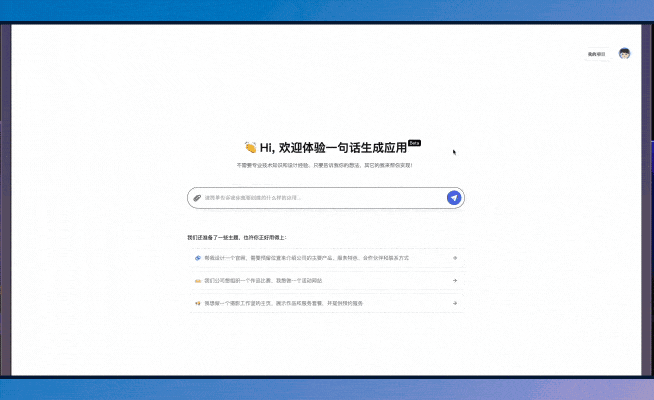
Requirement: "I want to make a guest invitation and management system for the new technology launch of Turnip Express and be able to collect their guesses and ideas."
Intelligence 0(Team Leader Intelligence)

Planning and scheduling as a team leader will break down the task and summon the various intelligences to complete the task.
Intelligence 1(Planning Intelligentsia)
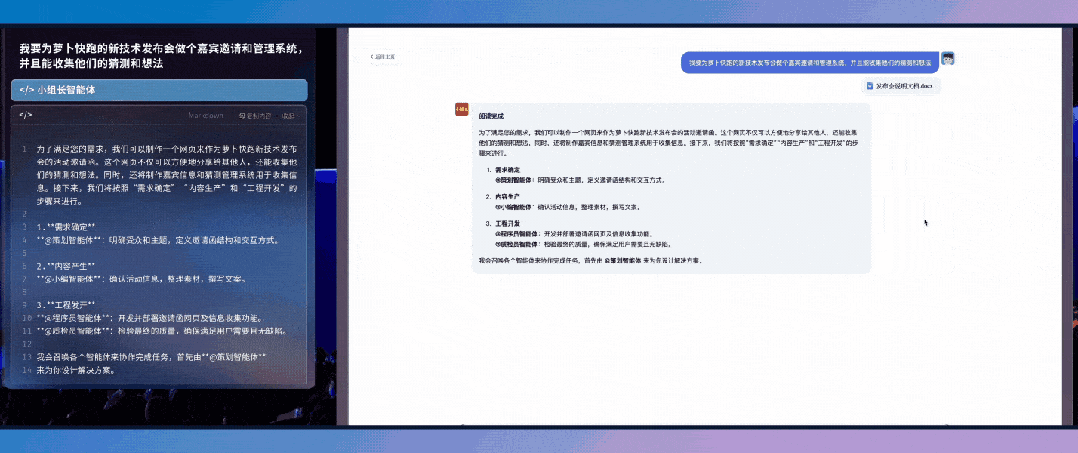
Split the planning and design solution into four subtasks: core requirements, content structure, development requirements, and data collection.
Intelligence 2(Editorial Intelligence)

Edit all text and media content in invitations, including release outlook, time and place information, cover art, etc.
Intelligence 3(Programmer's Intelligence)

Write code to create and deploy web pages.
Intelligence 4(QC Intelligentsia)
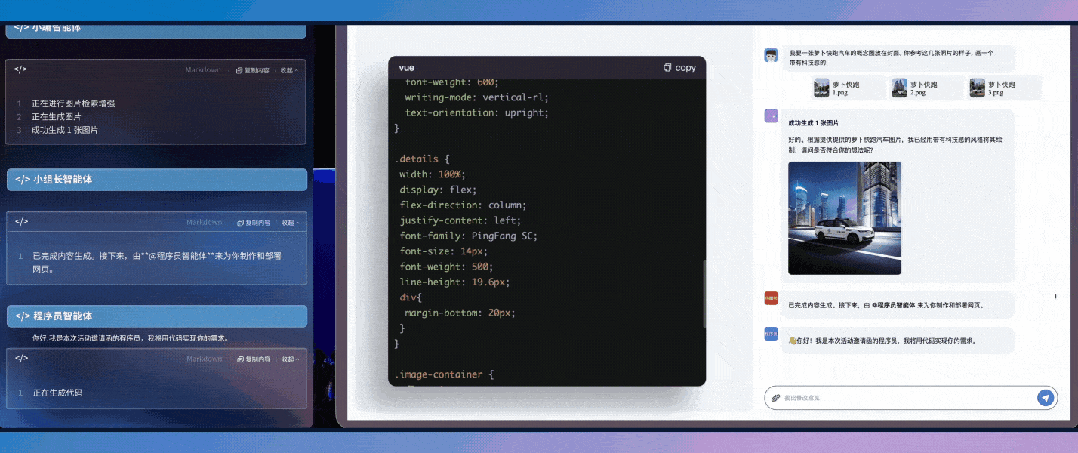
Checking code bugs and fixing them, performing code testing.
"Generate invitations in seconds.
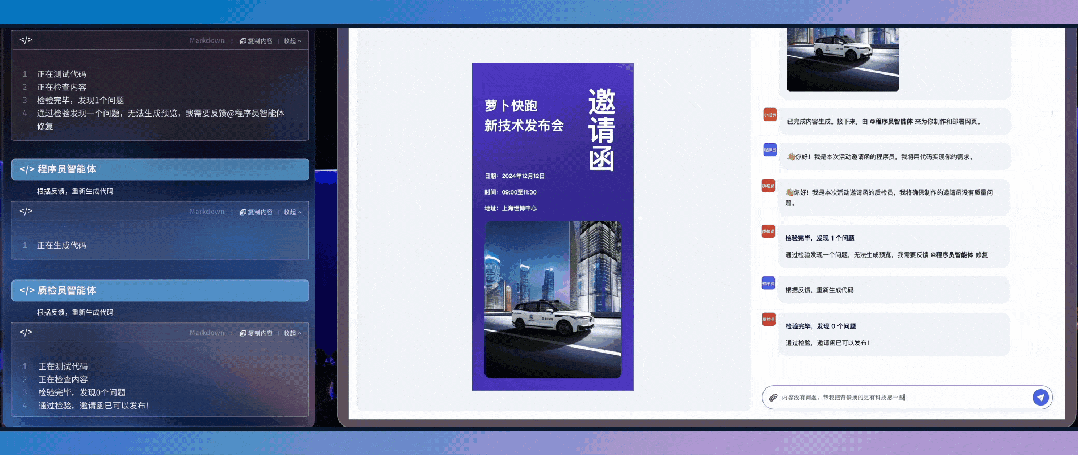
"Seconds da" generated invitations, you can also change the style of painting on demand.
Backstage view enrollment information

Check the backend, the enrollment information is already in the backend stats form.
The invitation system for such a launch takes only 3 minutes from the time you start to the final end, and the user doesn't have to write a single line of code.
The whole process embodies the whole process embodies the whole process embodies the whole process embodies the whole process embodies the whole process embodies theThree properties of secunda: the first is code-free programming, the second is multi-intelligence collaboration, and the third is multi-tool invocation.No code programming, is directly generated by the big model code, do not need to write a line of code, so the threshold is greatly reduced, everyone can do, everyone can start; multi-intelligent body collaboration, is based on the Wenxin big model thinking, planning and other capabilities, to achieve the scheduling, scheduling of different types of intelligences, there are a total of five intelligences collaborate to complete the task; multi-tool call, just now this example In this example, three tools are invoked: one is a webpage retrieval tool, he has to go to the Internet to find various kinds of information about RT6 to create; one is iRAG, which is the retrieval and generation of pictures, after we give RT6 pictures, we can keep the original accuracy and generate corresponding pictures; and there is also an API call for maps.
With Seconda, one person can build an entire system through natural language interaction.
In addition to the invitation system shown above, secada can also do a variety of applications in any scenario, and the complexity of the application will continue to increase with the improvement of our technology. The earliest start, it can only do some relatively simple programming, such as two or three hundred lines of code, later with the ability to improve the underlying model, as well as the evolution of the technical capabilities of the seconds da itself, it can do more and more, more complex things. What does this mean? It means that you don't need to recruit project managers, designers, developers, testers, etc., you can command multiple intelligences to collaborate on tasks. In other words, as long as you have an idea, you can do what you want, and we will usher in an unprecedented era where you can make money just by having an idea. In the past, there is an idea, you also have to go to the implementation of the idea out. Now as long as you have an idea, Seconda can do it for you.
ultimate
With the continuous progress of technology, "second da" is expected to be officially launched in January 2025 to provide services to more users. Robin Li emphasized that this tool will equip everyone with the ability to be a programmer, allowing ideas to be quickly transformed into practical applications, opening up a new digital era.
Through "Seconda", Baidu not only hopes to lower the threshold of software development, but also hopes to promote more people to participate in the digital economy, to realize a wider range of innovation and entrepreneurial opportunities. As Robin Li said, "As long as you have an idea, you can do whatever you want." This concept will lead us into a new code-free era.
© Copyright notes
Article copyright AI Sharing Circle All, please do not reproduce without permission.
Related posts

No comments...

